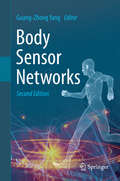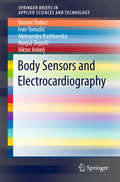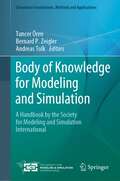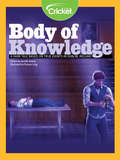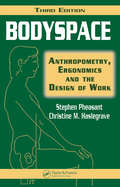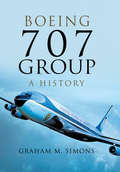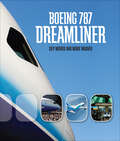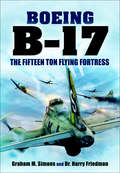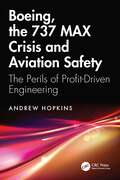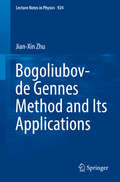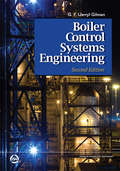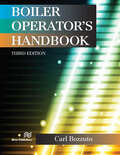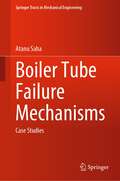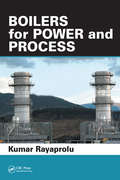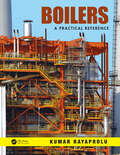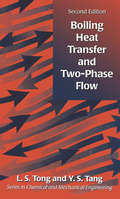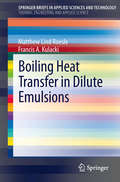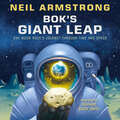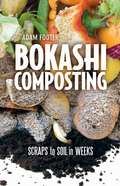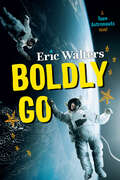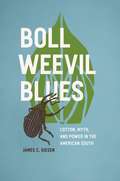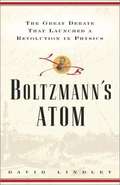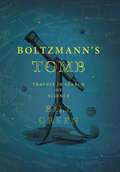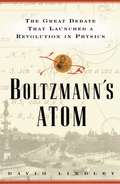- Table View
- List View
Body Sensor Networks
by Guang-Zhong YangThe last decade has witnessed a rapid surge of interest in new sensing and monitoring devices for wellbeing and healthcare. One key development in this area is wireless, wearable and implantable in vivo monitoring and intervention. A myriad of platforms are now available from both academic institutions and commercial organisations. They permit the management of patients with both acute and chronic symptoms, including diabetes, cardiovascular diseases, treatment of epilepsy and other debilitating neurological disorders. Despite extensive developments in sensing technologies, there are significant research issues related to system integration, sensor miniaturisation, low-power sensor interface, wireless telemetry and signal processing. In the 2nd edition of this popular and authoritative reference on Body Sensor Networks (BSN), major topics related to the latest technological developments and potential clinical applications are discussed, with contents covering. Biosensor Design, Interfacing and Nanotechnology Wireless Communication and Network Topologies Communication Protocols and Standards Energy Harvesting and Power Delivery Ultra-low Power Bio-inspired Processing Multi-sensor Fusion and Context Aware Sensing Autonomic Sensing Wearable, Ingestible Sensor Integration and Exemplar Applications System Integration and Wireless Sensor Microsystems The book also provides a comprehensive review of the current wireless sensor development platforms and a step-by-step guide to developing your own BSN applications through the use of the BSN development kit.
Body Sensors and Electrocardiography (SpringerBriefs in Applied Sciences and Technology)
by Roman Trobec Ivan Tomašić Aleksandra Rashkovska Matjaž Depolli Viktor AvbeljThis monograph presents a comprehensive overview of the electrocardiography from the aspect of wireless and mobile monitoring and its potential for personalized health management. The topical focus is on the implementation and efficient application of user friendly m-Health systems. The target audience comprises biomedical engineers, medical doctors, students, industrial experts and health managers developing m-Health solutions.
Body Toxic
by Susanne Paola AntonettaPoet Antonette expands her award winning essay "Elizabeth" into a memoir about growing up in a part of New Jersey that turned out to be one of worst polluted areas in the country. Her story is also that of a second-generation immigrant, her mother being from Italy and her father from Barbados. Earlier versions of some of the chapters have appeared in magazines. Annotation c. Book News, Inc., Portland, OR (booknews.com)
Body of Knowledge for Modeling and Simulation: A Handbook by the Society for Modeling and Simulation International (Simulation Foundations, Methods and Applications)
by Andreas Tolk Tuncer Ören Bernard P. ZeiglerCommissioned by the Society for Modeling and Simulation International (SCS), this needed, useful new ‘Body of Knowledge’ (BoK) collects and organizes the common understanding of a wide collection of professionals and professional associations.Modeling and simulation (M&S) is a ubiquitous discipline that lays the computational foundation for real and virtual experimentation, clearly stating boundaries—and interactions—of systems, data, and representations. The field is well known, too, for its training support via simulations and simulators. Indeed, with computers increasingly influencing the activities of today’s world, M&S is the third pillar of scientific understanding, taking its place along with theory building and empirical observation.This valuable new handbook provides intellectual support for all disciplines in analysis, design and optimization. It contributes increasingly to the growing number of computational disciplines, addressing the broad variety of contributing as well as supported disciplines and application domains. Further, each of its sections provide numerous references for further information. Highly comprehensive, the BoK represents many viewpoints and facets, captured under such topics as:Mathematical and Systems Theory FoundationsSimulation Formalisms and ParadigmsSynergies with Systems Engineering and Artificial IntelligenceMultidisciplinary ChallengesEthics and PhilosophyHistorical PerspectivesExamining theoretical as well as practical challenges, this unique volume addresses the many facets of M&S for scholars, students, and practitioners. As such, it affords readers from all science, engineering, and arts disciplines a comprehensive and concise representation of concepts, terms, and activities needed to explain the M&S discipline.Tuncer Ören is Professor Emeritus at the University of Ottawa. Bernard Zeigler is Professor Emeritus at the University of Arizona. Andreas Tolk is Chief Scientist at The MITRE Corporation. All three editors are long-time members and Fellows of the Society for Modeling and Simulation International. Under the leadership of three SCS Fellows, Dr. Ören, University of Ottawa, Dr. Zeigler, The University of Arizona, and Dr. Tolk, The MITRE Corporation, more than 50 international scholars from 15 countries provided insights and experience to compile this initial M&S Body of Knowledge.
Body of Knowledge: A Dark Tale Based on True Events in Dublin, Ireland
by Jennifer MasonTake a daunting journey into the "dissection theater." This fictional story will give you chills and thrills while presenting you with a plausible moral dilemma.
Bodyspace: Anthropometry, Ergonomics and the Design of Work, Third Edition
by Stephen Pheasant Christine M. HaslegraveIn the 20 years since the publication of the first edition of Bodyspace the knowledge base upon which ergonomics rests has increased significantly. The need for an authoritative, contemporary and, above all, usable reference is therefore great. This third edition maintains the same content and structure as previous editions, but updates the material and references to reflect recent developments in the field. The book has been substantially revised to include new research and anthropometric surveys, the latest techniques, and changes in legislation that have taken place in recent years. New coverage in the third edition: Guidance on design strategies and practical advice on conducting trials Overview of recent advances in simulation and digital human modes Dynamic seating · Recent work on hand/handle interface Computer input devices · Laptop computer use and children’s use of computers · Design for an aging population and accessibility for people with disabilities · New approaches to risk management and new assessment tools, legislation, and standards As the previous two editions have shown, Bodyspace is an example of the unusual: a text that is a favorite among academics and practitioners. Losing none of the features that made previous editions so popular, the author skillfully integrates new knowledge into the existing text without sacrificing the easily accessible style that makes this book unique. More than just a reference text, this authoritative book clearly delineates the field of ergonomics.
Boeing 707 Group: A History
by Graham M. SimonsA definitive look at the plane that revolutionized air travel and its place in aviation history from the author of Comet! The World&’s First Jet Airliner. The Boeing 707 family—that includes the forerunner Model 367-80, the KC-135 series of military transports and the slightly smaller Model 720—was the pioneer of the sweptback wing, incorporating podded engines borrowed from the B-47 military bomber. It was the aircraft that many regard as the design that really ushered in the Jet-Age. This book from the established aviation historian Graham Simons examines the entire course of the Boeing 707&’s history, charting an impressive design evolution and illustrating the many ways in which the 707&’s legacy continues to be felt to this day. In laying the foundation for Boeing&’s preeminence on the world&’s jetliner market during the 1980s and 90s, the 707 paved the way for future innovations in both civilian and military fields and Graham Simons has put together an image-packed history that records the historic and landmark milestones of this iconic aircraft type. &“The book is well worth the price and will provide many hours of intriguing reading and research support. It is a good addition to one&’s aviation bookshelf.&”—Air Power History &“An impressive volume that is well-written, and easy to read. Its research is of a high standard. It will, of course, appeal to Boeing 707/C-135 &‘enthusiasts&’ and as such could well become a &‘Standard Reference Work&’ on its subject.&”—NZ Crown Mines
Boeing 787 Dreamliner
by Mark Wagner Guy NorrisThe story behind the innovative widebody jet’s “troubled but also path-breaking development,” with hundreds of photos (Airways).With the launch of its superjumbo, the A380, Airbus made what looked like an unbeatable bid for commercial aviation supremacy. But archrival Boeing responded: Not so fast.Boeing’s 787 Dreamliner would generate more excitement—and more orders—than any commercial airplane in the company’s history. This book offers a fascinating behind-the-scenes look at the first all-new airplane developed by Boeing since its 1990 launch of the 777. With hundreds of photographs and diagrams, Boeing 787 Dreamliner closely details the design and building of Boeing’s new twin-engine jet airliner, as well as the drama behind its launch: the key players, the controversies, the critical decisions about materials and technology—the plastic reinforced with carbon fiber that make this mid-sized widebody super lightweight. And here, from every angle, is the Dreamliner itself, in all its gleaming readiness to rule the air.
Boeing B-17: The Fifteen Ton Flying Fortress
by Graham M. Simons Dr. Harry Friedman&“Fascinating insight into the early development of the B-17 Flying Fortress . . . undoubtedly outshines other books on this significant WWII aircraft.&” —Air Mail The Boeing B-17 was the first American heavy bomber to see action in World War II when it was supplied to the RAF. The design originated in 1934 when the US Air Corps was looking for a heavy bomber to reinforce air forces in Hawaii, Panama and Alaska. For its time, the design included many advanced features, and Boeing continued to develop the aircraft as experience of the demands of long-distance flying at high altitude was gained. When the United States entered WWII, production of the aircraft was rapidly increased and it became the backbone of the USAAF in all theaters of war. This book describes how it was built and utilizes many hitherto unpublished photographs from the design studio and production lines. It illustrates and explains the many different roles that the aircraft took as the war progressed. Heavy bomber, reconnaissance, antisubmarine, and air-sea rescue operations; there were few roles that this solid design could not adopt.
Boeing, the 737 MAX Crisis and Aviation Safety: The Perils of Profit-Driven Engineering
by Andrew HopkinsBoeing was once a symbol of engineering excellence, a company driven by the innovation and precision of its engineers. However, in the late 20th century, a shift in priorities – focusing on shareholder returns over passenger safety – marked a turning point that culminated in the tragic crashes of two 737 MAX aircraft and the global grounding of the fleet.This book explores how the pursuit of profit compromised safety principles, neglected human factors, and led to critical design failures that no one at Boeing had a complete view of. It examines the specifics of the Boeing crisis and looks at it in a broader industrial and economic context. This book draws from the author’s extensive research on other global industrial accidents, such as the Deepwater Horizon disaster, and highlights the dangers of profit-first decision-making, the necessity of robust safety systems, and the need for legal systems to respond effectively to corporate malfeasance. It demonstrates how neglecting safety as a top priority can lead to massive reputational damage in the airline industry. Written in an accessible style, this book brings clarity to complex issues, and readers will gain practicable insights into how companies, regulators, and stakeholders can better manage the risks of catastrophic failures.Boeing, the 737 MAX Crisis and Aviation Safety: The Perils of Profit-Driven Engineering is an essential read for professionals in the fields of human factors, safety, aeronautical/aerospace engineering, and law and corporate governance.
Bogoliubov-de Gennes Method and Its Applications (Lecture Notes in Physics #924)
by Jian-Xin ZhuThe purpose of this book is to provide an elementary yet systematic description of the Bogoliubov-de Gennes (BdG) equations, their unique symmetry properties and their relation to Green's function theory. Specifically, it introduces readers to the supercell technique for the solutions of the BdG equations, as well as other related techniques for more rapidly solving the equations in practical applications. The BdG equations are derived from a microscopic model Hamiltonian with an effective pairing interaction and fully capture the local electronic structure through self-consistent solutions via exact diagonalization. This approach has been successfully generalized to study many aspects of conventional and unconventional superconductors with inhomogeneities - including defects, disorder or the presence of a magnetic field - and becomes an even more attractive choice when the first-principles information of a typical superconductor is incorporated via the construction of a low-energy tight-binding model. Further, the lattice BdG approach is essential when theoretical results for local electronic states around such defects are compared with the scanning tunneling microscopy measurements. Altogether, these lectures provide a timely primer for graduate students and non-specialist researchers, while also offering a useful reference guide for experts in the field.
Boiler Control Systems Engineering
by G. F. Jerry GilmanThis book is for anyone who works with boilers: utilities managers, power plant managers, control systems engineers, maintenance technicians or operators. The information deals primarily with water tube boilers with Induced Draft (ID) and Forced Draft (FD) fan(s) or boilers containing only FD fans. It can also apply to any fuel-fired steam generator.
Boiler Operator's Handbook
by Carl BuzzutoWith the increased interest in climate impacts, sustainability, and efficiency, more responsibility is being placed on boiler operators to help improve performance and reduce emissions. This third edition of the Boiler Operator’s Handbook is intended to help such operators in the quest for improved operability and performance of their boilers and their plants. The theme of this book is to "operate wisely". The goal is to instill not only "know how" but "know why". The main details have been provided by the original author, Mr. Ken Heselton. This updated version has been somewhat expanded to include a wider range of examples and some of the more recent environmental requirements. To illustrate these points, topics include multi boiler operations, understanding the plant load, maintenance issues, and controls. Every plant is different. However, it is hoped that with the information provided in this book, the wise operator will be able to address the various unique issues posed by the specific plant and provide timely solutions to meet the present-day requirements.
Boiler Tube Failure Mechanisms: Case Studies (Springer Tracts in Mechanical Engineering)
by Atanu SahaThis book presents failure mechanisms of different boiler components and preventive measures. It illustrates the basic steam flow and circuit design of steam boiler, boiler design parameters, boiler components materials and their behavior at different temperatures. The book aims to identify the cause(s) of in-service failure of secondary superheater tube, platen superheater tube and furnace water wall tube and also presents the solutions to avoid the future failures. This volume will be of interest to researchers and professionals working in the areas of energy, power generation, electric power plants, thermodynamics, industrial chemistry, etc.
Boilers for Power and Process
by Kumar RayaproluBoiler professionals require a strong command of both the theoretical and practical facets of water tube-boiler technology. From state-of-the-art boiler construction to mechanics of firing techniques, Boilers for Power and Process augments seasoned engineers' already-solid grasp of boiler fundamentals. A practical explanation of theory, it d
Boilers: A Practical Reference
by Kumar RayaproluFollowing the publication of the author's first book, Boilers for Power and Process by CRC Press in 2009, several requests were made for a reference with even quicker access to information. Boilers: A Practical Reference is the result of those requests, providing a user-friendly encyclopedic format with more than 500 entries and nearly the same num
Boiling Heat Transfer And Two-Phase Flow
by L S TongCompletely updated, this graduate text describes the current state of boiling heat transfer and two-phase flow, in terms through which students can attain a consistent understanding. Prediction of real or potential boiling heat transfer behaviour, both in steady and transient states, is covered to aid engineering design of reliable and effective systems.
Boiling Heat Transfer in Dilute Emulsions (SpringerBriefs in Applied Sciences and Technology #8)
by Francis A. Kulacki Matthew Lind RoesleBoiling Heat Transfer in Dilute Emulsions synthesizes recent advances and established understanding on the subject of boiling in dilute emulsions. Experimental results from various sources are collected and analyzed, including contemporary experiments that correlate visualization with heat transfer data. Published models of boiling heat transfer in dilute emulsions, and their implementation, are described and assessed against experimental data.
Bok's Giant Leap: One Moon Rock's Journey Through Time and Space
by Neil ArmstrongFirst man on the moon Neil Armstrong's only children's book is a unique exploration of how the Earth and the Moon came to be.The entire epic history of the Earth and the Moon is recounted through the observations of one special moon rock named Bok. Geologists say that rocks remember, and Bok certainly does. It recounts how its life began on Earth, until a collision with an asteroid catapults it into orbit during the creation of the Moon. From the Moon's surface, Bok watches the developing planet change from afar--until a strange creature scoops him up and brings him back to Earth. When NASA honored Apollo 11 astronaut Neil Armstrong and gave him a piece of moon rock from that mission, Armstrong playfully named the rock Bok in his acceptance speech. Award-winning illustrator Grahame Baker-Smith has created a breathtaking, one-of-a-kind picture book based on that speech, combining fascinating science and history with the grandest human adventure of all.
Bokashi Composting
by Adam FooterBokashi composting relies on anaerobic fermentation in a closed system to recycle food waste in your kitchen, garage or apartment. Unlike conventional composting, the bokashi method can break down heavier items like meat, fish and cheese, and usually takes no more than two weeks. From scraps to soil, Bokashi Composting is a complete, step-by-step, do-it-yourself guide to this amazing process.
Boldly Go: Teen Astronauts #2 (Teen Astronauts #2)
by Eric WaltersTeen astronaut Houston Williams is finally headed into outer space. Houston Williams was thrilled to win a scholarship to attend a space program at NASA. What he didn’t realize was that organizers were recruiting people for a cutting-edge research project aimed at studying how space travel affects people of different ages. Now, after months of intense training, Houston is blasting off into space! He and his new friend and former rival, Ashley, are on their way to the International Space Station (ISS) where, along with veteran astronaut Colonel Sanderson, they will be subjected to a variety of experiments. Meanwhile, back on Earth, the politics of space travel are getting complicated. Many feel the money being spent on Mars exploration should be redirected to address issues such as access to clean water and global warming. A planned mission to Mars may be accelerated before funding is canceled, and there is talk of repurposing the ISS crew. Houston doesn't dare say out loud what he's thinking: Is there a chance he could actually be going to Mars? This is the second book in the Teen Astronauts series, following Houston, Is There A Problem?
Boll Weevil Blues: Cotton, Myth, and Power in the American South
by James C. GiesenBetween the 1890s and the early 1920s, the boll weevil slowly ate its way across the Cotton South from Texas to the Atlantic Ocean. At the turn of the century, some Texas counties were reporting crop losses of over 70 percent, as were areas of Louisiana, Arkansas, and Mississippi. By the time the boll weevil reached the limits of the cotton belt, it had destroyed much of the region’s chief cash crop—tens of billions of pounds of cotton, worth nearly a trillion dollars. As staggering as these numbers may seem, James C. Giesen demonstrates that it was the very idea of the boll weevil and the struggle over its meanings that most profoundly changed the South—as different groups, from policymakers to blues singers, projected onto this natural disaster the consequences they feared and the outcomes they sought. Giesen asks how the myth of the boll weevil’s lasting impact helped obscure the real problems of the region—those caused not by insects, but by landowning patterns, antiquated credit systems, white supremacist ideology, and declining soil fertility. Boll Weevil Blues brings together these cultural, environmental, and agricultural narratives in a novel and important way that allows us to reconsider the making of the modern American South.
Boltzman's Atom
by David LindleyDescribes the history of Boltzman and his work in discovering atoms. Also goes into the philosophical debates involved.
Boltzmann's Tomb
by Bill GreenA selection of the Scientific American book clubRecommended by MSNBC, Los Angeles Times, & American Association for the Advancement of Science's SB&F magazine"This wonderful scientific memoir captures the romance and beauty of research in precise poetic prose that is as gorgeous and evocative as anything written by Rilke, painted by Seurat, or played by Casals." -Mary Doria Russell, author of Doc and The Sparrow"A radiant love letter to science from a scientist with a poet's soul . . . Green is an exquisite writer, and his fierce focus and mastery of style are reminiscent of the biologist and essayist Lewis Thomas." -Kirkus ReviewsIn Boltzmann's Tomb, Bill Green interweaves the story of his own lifelong evolution as a scientist, and his work in the Antarctic, with a travelogue that is a personal and universal history of science. Like Richard Holmes' The Age of Wonder-this book serves as a marvelous introduction to the great figures of science. Along with lyrical meditations on the tragic life of Galileo, the wildly eccentric Tycho Brahe, and the visionary Sir Isaac Newton, Green's ruminations return throughout to the lesser-known figure of Ludwig Boltzmann. Using Boltzmann's theories of randomness and entropy as a larger metaphor for the unpredictable paths that our lives take, Green shows us that science, like art, is a lived adventure. Bill Green is a geochemist and professor emeritus at Miami University in Oxford, Ohio. He is also the author of Water, Ice & Stone: Science and Memory on the Antarctic Lakes which received the American Museum of Natural History's John Burroughs Award for Nature Writing, was a finalist for the PEN/Martha Albrand Award, and was excerpted in The Ends of the Earth: An Anthology of the Finest Writing on the Arctic and the Antarctic, edited by Elizabeth Kolbert.
Boltzmanns Atom: The Great Debate That Launched A Revolution In Physics
by David LindleyIn 1900 many eminent scientists did not believe atoms existed, yet within just a few years the atomic century launched into history with an astonishing string of breakthroughs in physics that began with Albert Einstein and continues to this day. Before this explosive growth into the modern age took place, an all-but-forgotten genius strove for forty years to win acceptance for the atomic theory of matter and an altogether new way of doing physics. Ludwig Boltz-mann battled with philosophers, the scientific establishment, and his own potent demons. His victory led the way to the greatest scientific achievements of the twentieth century. Now acclaimed science writer David Lindley portrays the dramatic story of Boltzmann and his embrace of the atom, while providing a window on the civilized world that gave birth to our scientific era. Boltzmann emerges as an endearingly quixotic character, passionately inspired by Beethoven, who muddled through the practical matters of life in a European gilded age. Boltzmann's story reaches from fin de siècle Vienna, across Germany and Britain, to America. As the Habsburg Empire was crumbling, Germany's intellectual might was growing; Edinburgh in Scotland was one of the most intellectually fertile places on earth; and, in America, brilliant independent minds were beginning to draw on the best ideas of the bureaucratized old world. Boltzmann's nemesis in the field of theoretical physics at home in Austria was Ernst Mach, noted today in the term Mach I, the speed of sound. Mach believed physics should address only that which could be directly observed. How could we know that frisky atoms jiggling about corresponded to heat if we couldn't see them? Why should we bother with theories that only told us what would probably happen, rather than making an absolute prediction? Mach and Boltzmann both believed in the power of science, but their approaches to physics could not have been more opposed. Boltzmann sought to explain the real world, and cast aside any philosophical criteria. Mach, along with many nineteenth-century scientists, wanted to construct an empirical edifice of absolute truths that obeyed strict philosophical rules. Boltzmann did not get on well with authority in any form, and he did his best work at arm's length from it. When at the end of his career he engaged with the philosophical authorities in the Viennese academy, the results were personally disastrous and tragic. Yet Boltzmann's enduring legacy lives on in the new physics and technology of our wired world. Lindley's elegant telling of this tale combines the detailed breadth of the best history, the beauty of theoretical physics, and the psychological insight belonging to the finest of novels.
